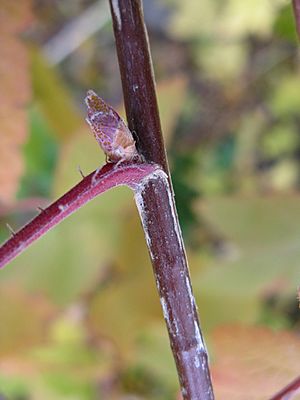Axillary bud facts for kids
An axillary bud is a tiny, undeveloped shoot found on a plant. Think of it like a mini-plant waiting to grow! It's located right where a leaf meets the main stem of a plant. These little buds are super important because they can grow into new branches, leaves, or even flowers.
Contents
What is an Axillary Bud?
An axillary bud is also called a "lateral bud." It's a small, special part of a plant that contains everything needed to start new growth. It's made of very young, undeveloped plant tissues, like a tiny blueprint for a new branch or flower.
Where Do Axillary Buds Grow?
You can find an axillary bud in a specific spot on a plant: in the "axil" of a leaf. The axil is the angle formed between the upper side of a leaf stem (called the petiole) and the main plant stem. Imagine your arm (the leaf) sticking out from your body (the main stem); the armpit area is similar to where the axillary bud is located.
What Do Axillary Buds Do?
Axillary buds are like the plant's backup plan or its growth engines. They have several important jobs:
- New Branches: They can grow into new side branches, helping the plant become bushier and produce more leaves for photosynthesis.
- Flowers: In many plants, axillary buds are where flowers develop. This is how plants reproduce and make seeds.
- Leaves: Sometimes, they just grow into new sets of leaves, especially if the main growing tip of the plant is damaged.
- Dormancy: Axillary buds can stay "asleep" or dormant for a while, waiting for the right conditions (like more sunlight or nutrients) before they start to grow.
How Do Axillary Buds Help Plants?
Axillary buds are vital for a plant's survival and growth.
- Increased Growth: By forming new branches, they help the plant get more sunlight and produce more food.
- Repair: If the main growing tip of a plant (called the apical bud) is damaged or removed, axillary buds can take over and continue the plant's growth. This is why pruning a plant often makes it grow bushier.
- Reproduction: Since many flowers grow from axillary buds, they are key to the plant's ability to make seeds and reproduce.
- Adaptation: Their ability to stay dormant helps plants survive harsh conditions, like winter, and then grow again when conditions improve.
Axillary Buds in Everyday Life
You might not realize it, but axillary buds are important in many ways we interact with plants:
- Gardening and Pruning: When gardeners "pinch back" a plant, they are often removing the main growing tip. This encourages the axillary buds to grow, making the plant fuller and more productive.
- Food: Some vegetables we eat are actually enlarged axillary buds! For example, Brussels sprouts are axillary buds that have grown into small, edible heads.
- Tree Shape: The way a tree branches out and forms its unique shape is largely due to the growth patterns of its axillary buds.
How Plants Control Bud Growth
Plants use special chemical messengers called hormones to control when and how axillary buds grow.
- Apical Dominance: The main growing tip (apical bud) often produces hormones that stop the axillary buds below it from growing. This is called apical dominance, and it makes the plant grow taller rather than wider.
- Branching: If the apical bud is removed or damaged, the hormones that suppress axillary bud growth are reduced. This allows the axillary buds to "wake up" and start growing, leading to more branching.
So, while they might be small, axillary buds play a huge role in how plants grow, survive, and reproduce!
See also
 In Spanish: Yema axilar para niños
In Spanish: Yema axilar para niños


